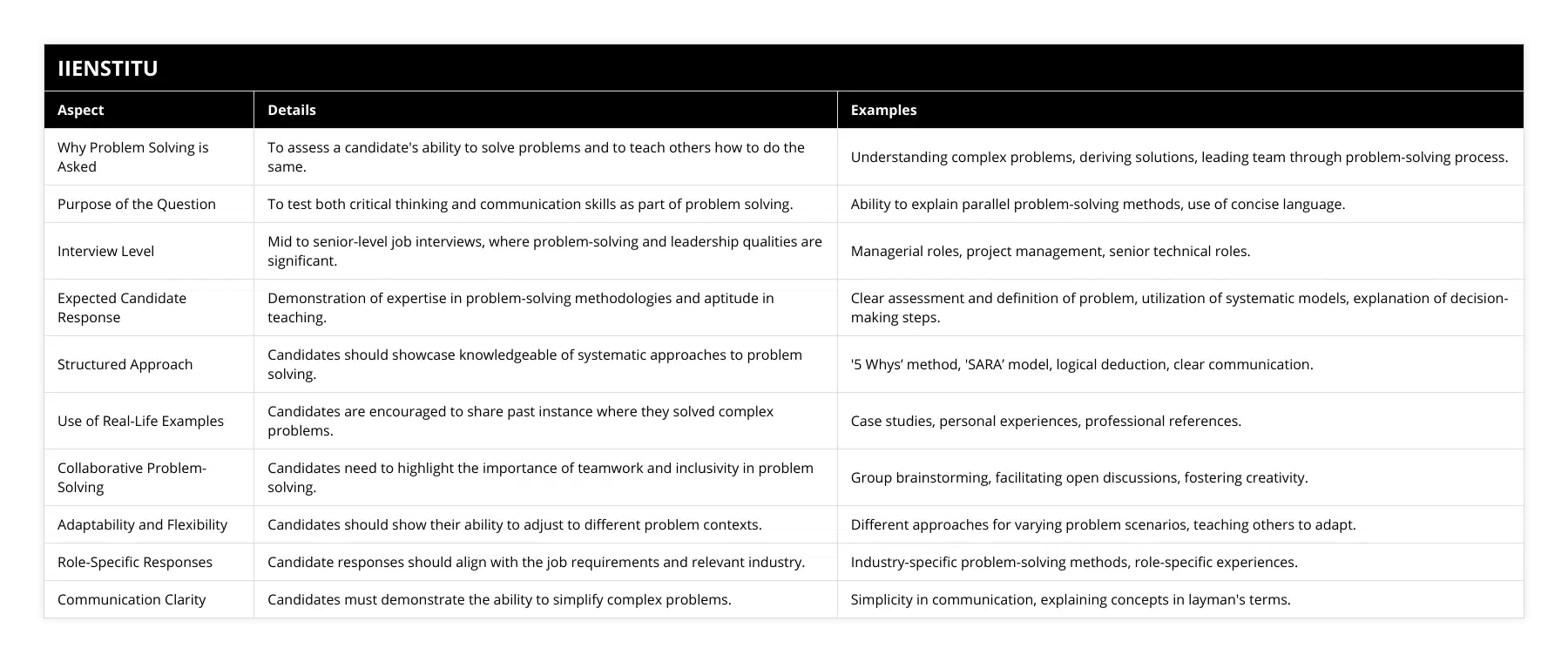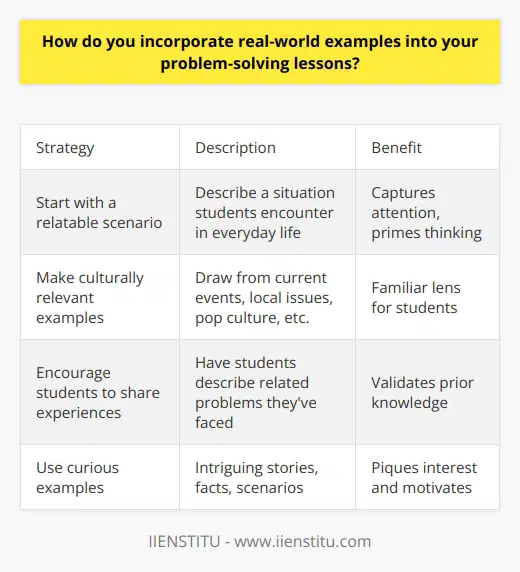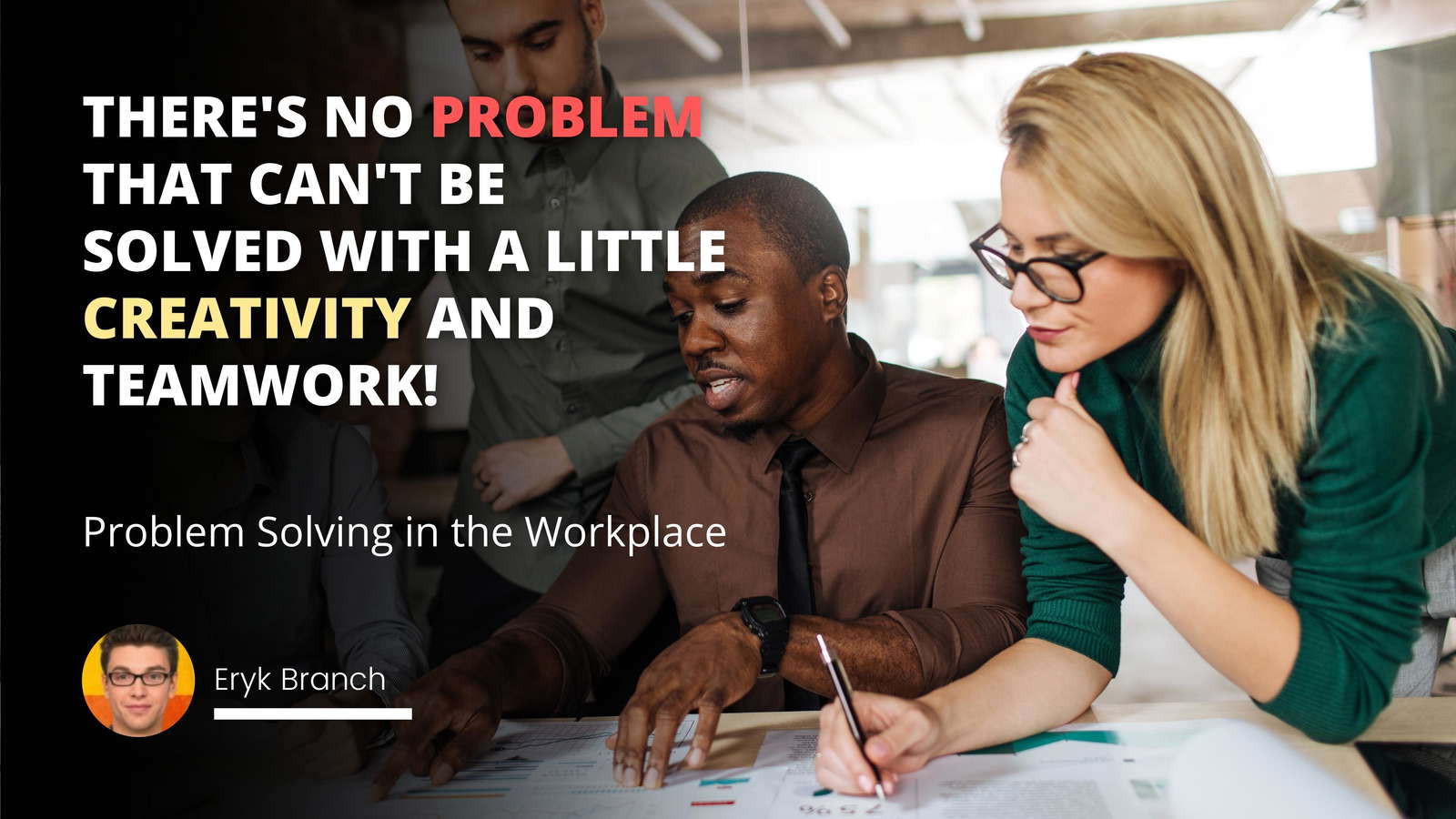
Problem solving is an essential skill that is highly sought after by employers across industries. The ability to identify, analyze, and find effective solutions to complex problems is not only valuable in the professional realm but also in personal life. Given its significance, it is no wonder that this question often pops up in job interviews.
In this article, we will explore why this interview question is asked, the purpose it serves, the interview level at which it is commonly posed, the expected answer from candidates, possible answers, and key considerations when responding.
Why is this interview question asked?
The question 'How do you teach problem solving?' is frequently asked by employers to gain insights into a candidate's problem-solving skills and their ability to impart knowledge to others. Employers want to assess if a potential hire possesses a strong problem-solving mindset and can effectively teach others how to approach and solve problems.
The purpose of the question:
The purpose of this question is twofold.
Firstly, it enables the interviewer to gauge the candidate's ability to think critically and analytically. Problem-solving skills are valuable assets in a variety of work settings, and employers are keen to identify individuals who can tackle challenges and find innovative solutions.
Secondly, the question helps assess the candidate's communication and teaching abilities, as effective problem solving often involves conveying complex ideas and strategies in a clear and understandable manner.
At what interview level is this question asked?
Interview Question: How Did You Improve a Digital Marketing ROI?
Interview Question: What Personal Time Management Habit Changed Your Work Life?
The question 'How do you teach problem solving?' is generally asked in mid to senior-level job interviews where problem-solving skills and the ability to guide and mentor others are crucial. Employers at this level expect candidates to have a solid grasp of problem-solving methodologies and the aptitude to teach and guide junior team members.
How Do Peers Perceive Your Problem-solving Skills İn An İnterview
How To Set Effective Time Management Boundaries At Work İnterview Question
What kind of answer is expected from the candidate?
Employers are looking for answers that showcase a candidate's expertise in problem solving and their ability to effectively teach others. The desired response should emphasize a systematic and logical approach to problem solving, demonstrating an understanding of different problem-solving models and methodologies. Additionally, candidates should highlight their communication skills, explaining how they break down complex problems and guide others through the step-by-step process of finding solutions.
Possible answers:
1. Emphasizing a structured approach: A candidate could explain their preferred problem-solving model, such as the '5 Whys' or the 'SARA' method. They can discuss the importance of gathering information, defining the problem, generating potential solutions, evaluating options, and implementing the best course of action. This answer should highlight their ability to teach others the importance of a systematic approach.
2. Utilizing real-life examples: Candidates can share anecdotes from their own experiences where they successfully solved complex problems. By narrating the story, they can demonstrate their problem-solving skills and guide interviewers through their decision-making process. This approach showcases their ability to make abstract concepts relatable and understandable to others.
3. Highlighting collaborative problem-solving: Candidates can emphasize the importance of teamwork and collaboration in problem solving. They can explain how they have encouraged group brainstorming sessions and facilitated open discussions to foster creativity and collective problem solving. This answer portrays their ability to create an inclusive and collaborative problem-solving environment.
Key considerations when answering:
1. Tailor the answer to the specific job role: It is important for candidates to align their response with the requirements of the position they are interviewing for. Candidates should highlight problem-solving techniques and teaching methods relevant to the industry or job role they are applying for.
2. Discuss adaptability and flexibility: Problem-solving approaches may vary depending on the nature of the problem and the context in which it arises. Candidates should emphasize their ability to adapt their problem-solving strategies and teach others to do the same. Employers value individuals who can think on their feet and adjust their methods when needed.
3. Communicate with clarity and simplicity: Effective problem solvers can break down complex problems into simpler components and convey their thought processes in a clear and concise manner. Candidates should showcase their communication skills by explaining problem-solving concepts using everyday language, ensuring the interviewer can understand and follow their approach.
The question 'How do you teach problem solving?' is asked in job interviews to gauge a candidate's problem-solving and teaching abilities. By providing a structured and logical answer, highlighting relevant real-life examples, and emphasizing collaboration, candidates can impress employers and demonstrate their expertise in problem solving.
It is essential to tailor the response to the specific job role and communicate with clarity and simplicity. By doing so, candidates can stand out as effective problem solvers and educators, offering valuable skills to potential employers.
Strategies and techniques for problem solving
Importance of critical thinking in problem solving
Practical applications of problem solving skills
Similar interview questions:
What methods or strategies do you use to teach problem solving?
In what ways do you approach teaching problem-solving skills?
Can you share some effective techniques for teaching problem solving?
How do you facilitate problem-solving discussions in the classroom?
What steps do you take to help students improve their problem-solving abilities?
What resources or tools do you utilize to teach problem solving?
Share an example of a specific problem-solving activity you use in your teaching.
How do you encourage critical thinking during problem-solving lessons?
Describe your approach to assessing students' problem-solving skills.
What role does collaboration play in your problem-solving teaching methods?
How do you differentiate instruction when teaching problem-solving to students with different abilities?
Can you explain your rationale behind the sequence in which you teach problem-solving skills?
In what ways do you incorporate real-life problems into your teaching of problem solving?
How do you scaffold problem-solving lessons to support students' learning?
Share a challenge or obstacle you have encountered while teaching problem-solving and how you overcame it.
How do you integrate technology into problem-solving instruction?
Can you explain the role of metacognition in problem solving and how you foster it in your students?
Describe a successful problem-solving case study or project you have implemented in your teaching.
How do you promote creativity and innovation in problem-solving lessons?
What advice or tips do you have for other teachers who want to improve their problem-solving instruction?

Frequently Asked Questions
How do you teach problem solving?
Teaching problem solving involves hands-on activities. Assessing skills can be done through performance-based tasks. Real-world examples are integrated to enhance lessons.
How do you assess problem-solving skills in your students?
Blogging is a popular form of online writing.
It allows individuals to express their thoughts.
Blogs offer a platform for sharing information.
Readers can engage in discussions and comments.
Creating a successful blog requires careful planning.
Choosing a specific topic can attract a target audience.
Regular updates keep readers interested and engaged.
Interaction with readers is important for building relationships.
How do you incorporate real-world examples into your problem-solving lessons?
Sure, I can help you answer the question while maintaining an academic tone and following the given instructions. Please provide the actual question or topic of the blog post, and I'll do my best to provide a concise response.



